Latrunculi XXI
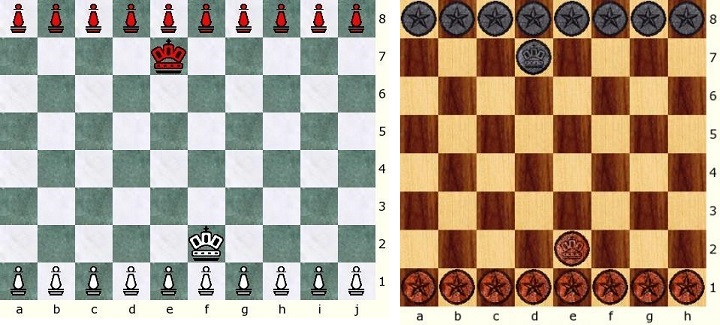
Diagram 1 - Latrunculi (on 10x8 and 8x8 boards)
Latrunculi (Ludus latrunculorum or the Game of Little Soldiers) was an ancient strategy game played throughout the Roman Empire.
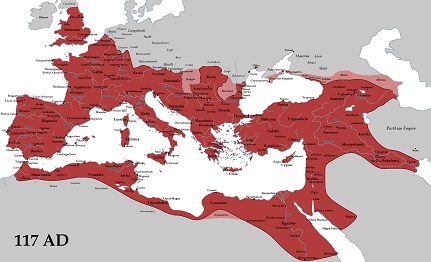
The Roman Empire in 117 AD, at its greatest extent
This colorful description of what is most definitely Latrunculi comes from a poem in Latin known as Laus Pisonis which was written by Saleius Bassus during the middle of the 1st century A. D.:
Cunningly the pieces are disposed on the open board and battles are fought with soldiery of glass, so that now White blocks Black, now Black blocks White. But every foe yields to thee, Piso; marshalled by thee, what piece ever gave way? What piece on the brink of death dealt not death to his enemy? Thousand-fold are thy battle tactics: one man in fleeing from an attack himself overpowers him, another, who has been standing on the look-out, comes up from a distant corner; another stoutly rushes into the melee and cheats his foe now creeping on his prey; another courts blockade on either flank and under feint of being blocked, himself blocks two men; another's objective is more ambitious, that he may quickly break through the massed phalanx, swoop into the lines and, razing the enemy's rampart, do havoc in the walled stronghold. Meantime, although the fight rages fiercely, the hostile ranks are split, yet thou thyself are victorious with serried lines unbroken or despoiled maybe of one or two men and both thy hands rattle with the prisoned throng.
Although Latrunculi resembles chess or draughts in some ways, it is generally accepted to be a game of military tactics. Because of the lack of reliable sources, reconstruction of the original game rules is difficult, and there are multiple interpretations of the available evidence. Latrunculi is believed to be similar or a variant of an earlier Greek game known as Petteia (a.k.a. Poleis, Cities or the Game of Pebbles).
Latrunculi and Petteia can be thought of as the Chess and Draughts of the Roman Empire and of Ancient Greece.
Latrunculi XXI is one of two ancient abstract strategy games that I reengineered in 2015 to introduce my son Joseph to the world of variants. My other variant, Petteia XXI, is played with the same rules as Latrunculi XXI, except for the fact that the Duxes (Kings) are removed.
Petteia XXI is not only a good alternative game for Draughts-variant lovers; but also a great training tool for Latrunculi XXI players, to get experience with moves and the tactics of the men, soldiers or pawns.
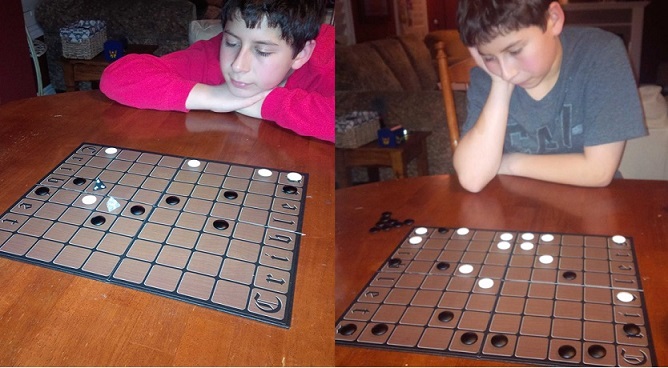
Diagram 2 - My son Joseph and I playing Latrunculi XXI and Petteia XXI, using Japanese Go stones to represent the soldiers, and 4-sided dice to represent the Duxes. We are using a 10x8 board for a cards game called Criblets.
Below are two Latrunculi XXI setups:
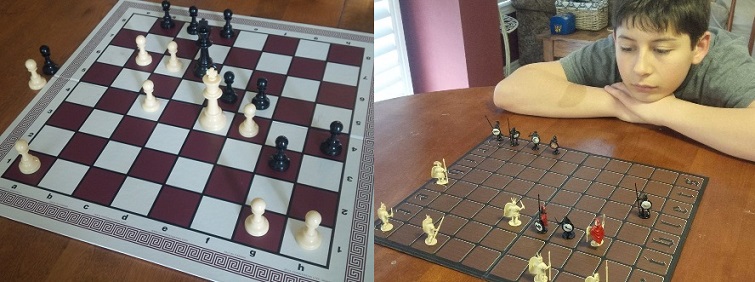
Diagram 3 - Position (8x8 board on left) after 8... g4-g3 - Francis Fahys vs Jose Carrillo, July 2016; and (right) my son Joseph playing OTB.
On the right above, Joseph and I are playing on a 10x8 board with tiny soldier figurines (representing Roman and Greek armies). The Duxes (Kings) are the ones with the red coats. All other pieces represent regular soldiers.
My objective when I created Latrunculi XXI was to make a set of rules and tactics for the ancient Roman game, which (leveraging my chess background) would allow a modern Latrunculi player to force a win on his/her opponent, therefore minimizing the number of draws, without relying on any serious mistakes in play by one side or the other.
Latrunculi XXI is a crossover variant which builds on the principles of the ancient Roman game and combines them with chess-like concepts, nomenclature, tactics and strategy to become a new Latrunculi Variant as well as a new Chess Variant.
At first the rules of Latrunculi XXI may seem long and complicated, but as you will quickly find out, the game is actually quite easy to play.
Learning to move the pieces is the easy part. Mastering the strategy and tactics needed to bring the opponent's Dux to its knees, is the real challenge of this variation of the ancient Roman game.
Setup

Diagram 4 - A 10x8 Latrunculi opening setup, displaying reverse symmetry
The Latrunculi opening setup is as follows: (on a 10x8 Capablanca board)
White:
Dux (Leader or King) f2; Soldiers (or Pawns) a1, b1, c1, d1, e1, f1, g1, h1, i1, j1
Black:
Dux (Leader or King) e7; Soldiers (or Pawns) a8, b8, c8, d8, e8, f8, g8, h8, i8, j8
There is reverse symmetry between the two armies, similar to Chaturanga
Latrunculi XXI can be played on different size boards. The 12x8 Courier Chess board was likely the most popular board size used in the Roman Empire. But archeological findings show that the Romans may have used other board-sizes too.
Regardless of the size of the board, the general rule for the opening setup for Latrunculi is: Soldiers (Pawns) are placed on each of the players 1st-rank squares, and the Leader or Dux (King) is placed on the right square of the two middle squares in his/her 2nd rank. In the initial formation, you can see the brave Dux leading the charge of his army against the enemy formation.

Diagram 5 - Sample 12x8, 10x8 and 8x8 Latrunculi opening setups
A Latrunculi board itself is called the City, and the edges of the board represent the Walls of the city. The Walls of the City (the edges of the board) take an important role in the development of some of the battles in Latrunculi XXI.

When you play Latrunculi, picture yourself battling with your opponent inside a medieval walled city, like the one above. This one is Monteriggioni in the province of Siena in Italy.
Pieces
All pieces (Duxes and Soldiers) move orthogonally any number of squares, just like Orthodox Chess Rooks. No diagonal moves are allowed. Pieces cannot jump other pieces.However, unlike in Chess, captures in Latrunculi are done by custodial attacks, similar to how it's done in other games like: Hasami Shogi, by the pawns in Robert Abbott's Ultima or the rooks in Custodian Chess; a type of capture common to other games like Seega (Egypt) and the Scandinavian family of Tafl games.
A 2nd piece must move in to attack, by surrounding either horizontally or vertically, an enemy soldier (already in attack) to perform a capture.

Diagram 6 - Sample custodial captures
After white plays: d1-d5xc5 and black plays: ... De6-i6xi7 (right diagram), the c5 and i7 soldiers are captured and removed from the board.
However it is possible for a piece to move in between two men, without risking an immediate capture (or suicide) of the moving piece.
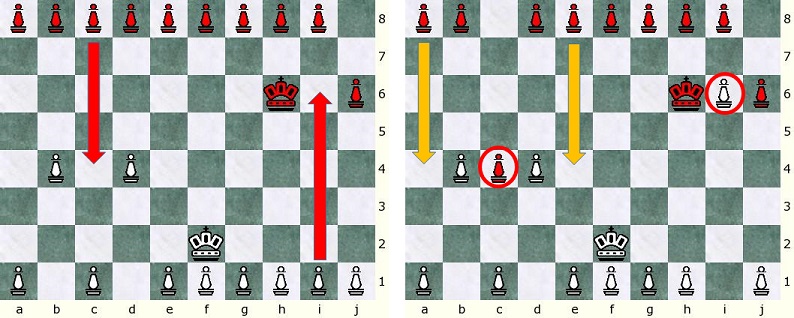
Diagram 7 - Soldiers moving safely between two enemy pieces: white plays i1-i6*, and black ... c8-c4
The '*' after white's move shows that the soldier blocked one of the sides of enemy black Dux
This time the soldiers at c4 and i6 are perfectly safe. The black soldier at c4 is said to be sandwiched-in, but this time (for the time being) is actually well positioned and has a relative fork on white's b4 and d4 soldiers, as with black's next move a8-a4 or e8-e4 (orange arrows), one of the two white soldiers will fall.
A situation that can occur in Latrunculi (but not in Chess) happens when a piece moves in such a way that more than one enemy soldier is captured. Look at the example below:

Diagram 8 - Dual Capture, positions after 13.j1-f1? (left) and after 13...h3-g3xf3xg4 (right), Arx vs Jose Carrillo, CV Game Courier, December 2016
The soldier at h3 moves to g3 and surrounds both of white's f3 and g4 soldiers (which are currently in one-to-one combats, and performs two custodial-captures at once. The notation for this move is: h3-g3xf3xg4
Since Latrunculi uses custodial captures (capture by surrounding) as the principal offensive tactic to capture enemy soldiers, it always takes at least two soldiers to perform a capture.

Diagram 9 - Sample custodial attacks and a corner attack
The example above shows the two soldiers (at d1 and g4) that can move to d4, surround and capture the enemy soldier at c4, who is already locked in a one-to-one combat with the b4 soldier.
A special type of custodial capture is shown at the top corner of the board. This time, the black j8 soldier is already in a one-to-one combat with the white i8 soldier. The white j5 soldier can play to j7 to surround the black soldier in the corner against the walls of the city, and to capture him. Remember! It takes at least two soldiers to capture an enemy soldier.
Rules
The goal of the game is to immobilize (the Roman's way to checkmate) or to Bare the opponent's Dux (King).
In Latrunculi XXI, stalemate is a loss for the stalemated player, there is 50-move draw rule and the Threefold Repetition rule gives a loss for the player forcing the 3rd repetition. A player left with a lone Dux loses the game.
Draws are discouraged in Latrunculi XXI. However, players can agree to a draw if they believe that the position merits that outcome. If the game goes for 50 moves without a capture, the game is automatically a draw.
Look at the sample immobilized Duxes below:
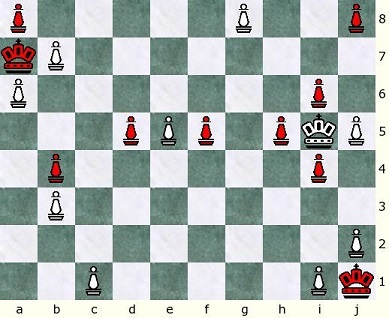
Diagram 10 - Sample immobilized (or checkmated) Duxes
The white Dux at i5 is surrounded in all four directions. The black Dux at a7 is also immobilized, but this time, since the black Dux has its back to the Wall of the City (edge of the board), it only takes three soldiers to immobilize him.
The black Dux at j1 is in one of the most vulnerable squares of the board for a Dux, a corner square. Having two sides already covered by the Walls of the City there, it only takes two soldiers to immobilize him.
Note that not all the soldiers surrounding (and therefore immobilizing) the Dux need to be enemy soldiers. The Dux can be the victim of a smothered mate when he is attacked by an enemy soldier, and his only escape paths are blocked by his own men.
How does the Ancient Roman way to immobilize an opponent compare to a traditional Chess checkmate?

Diagram 11 - An Orthodox Chess' checkmate and a Latrunculi immobilization
The objective in orthodox chess: to checkmate, is really to create an attack that causes the enemy King to be immobilized in a position where the King cannot escape the threat of capture. In the diagram on the left above, white attacks with the Rook (at d8) and immobilizes the black King in a position that he cannot escape from.
Similarly, the Roman way to checkmate also involves an attack that causes the enemy Dux (King) to be immobilized, but this time in a position where the Dux is "smothered" without any open paths available to flee. In the diagram on the right above, white attacks with the Soldier (at c8) to smother and immobilize the black King in a position that he cannot escape from. In Latrunculi there is no need to have a threat of capture to end the game. Blocking all of the Dux' adjacent orthogonal paths does the trick.
Interestingly, in both the Orthodox Chess and Latrunculi checkmate examples above, the paths for escape of the royal pieces are blocked by their own friendly pawns or soldiers.
Here is a sample checkmate from real play:

Diagram 12 - Position after 16.f6-f4#, Jose Carrillo vs Carlos Cetina, CV Game Courier, July 2016
The checkmate above is an example of a double custodial attack. White has two custodial attacks on the black Dux: the g3-Dux + e3-soldier and the f4 & f2 soldiers. The first custodial attack locked the black Dux to the f3-square (see rule 17 below), the f2-soldier partially-immobilized the black Dux (causing a check [by the d4-soldier] and creating a mating net); and the second attack completed by the white f4-soldier smothered the black Dux for the win.
To summarize, the rules so far (which also typically apply to the Classical Latrunculi game):
- The object of the game is:
- To immobilize or
- To Bare the opponent's Dux.
- However, it's illegal for a player to immobilize his own Dux.
- A player without any legal moves is stalemated and loses the game.
- All pieces move like Orthodox Chess Rooks.
- Pieces can neither play diagonally nor jump each other (like in checkers or draughts).
- Soldiers are captured by means of the custodial attacks tactic (moving in to surround an enemy soldier between two friendly pieces).
- A piece can move safely in between two enemy pieces, without being captured.
- Multiple soldiers can be captured in one turn. (example: creating multiple custodial capture situations with the same move)
- A soldier in a corner of the board can be captured if surrounded an attacked both vertically and horizontally.
- Captures are not mandatory. (just like in chess)
These rules provide the basics for an interesting new game. However, without a few additional new rules, a game played between two strong players will always end up in a draw, as the rules above do not allow a player to force a win on his opponent unless one of the players made several serious errors in his/her play. A game that can at best end in a draw (if well played) would be a boring game.
Since all pieces move like rooks, special rules exist in Latrunculi XXI to limit mobility or to allow special captures, otherwise games played with the classical rules could turn into drawish back and forth move affairs, where players try to maintain their soldiers on the diagonals, so as to avoid damaging their position. Look at this example:

Diagram 13 - Sample Classical Latrunculi diagonals-formation
With the reconstructed Classical Latrunculi rules, by keeping their soldiers in the diagonals, players can continue to move back and forth to protect their position, and the game would result in nothing but a lengthy and boring draw.
What follows now is my special set of additional rules that make Latrunculi XXI into a very playable game that does not depend on anyone making serious errors in play, and yet they give the game the spirit of a battle, just like any other Chess Variant.
New Latrunculi XXI Tactics:
- Locked Soldiers
- Push and Crush attack
- Flank attack
- Testudo formation and Phalanx attack
- Dux Mobility Rules (sides attacked)
- 0 sides: Full mobility
- 1 side : One step only
- 2 sides: Only for offensive strikes
- 3 sides: Can't move. Partially immobilized. (i.e. check)
- 4 sides: Immobilized (i.e. checkmate)
- Quasi Check
- Check and Checkmate
Latrunculi XXI additional rules
- Definition #1 - There are two types of moves in Latrunculi XXI:
- Offensive Moves
- Captures
- Hits on the enemy Dux (block one of its orthogonal paths)
- Non-Offensive Moves
- Everything else (defensive, escapes, strategic, etc.)

Diagram 14 - Sample offensive moves
All moves above are offensive moves as they either complete a capture, or orthogonally hit the enemy Dux. Any other move would be non-offensive.
- Offensive Moves
- Definition #2 - In Latrunculi XXI, a skirmish is defined as a situation where a piece is orthogonally adjacent to an enemy piece. A group of three or more enemy pieces engaged in more than one skirmish is called a melee.

Diagram 15 - Sample skirmishes and melees
- One-on-one skirmishes: d7 soldier with Dux at e7, and i8-j8 soldiers
- Two-on-one melees: the following trios: a6-a5-b5, a5-b5-b4, f4-f3-f2, i6-i5-j5, i2-i3-j3
- Three-on-one melee: the a1-b2-c1-b1 group
- Melees: all of the groups above, except for the i8-j8 and d7-e7-e6 groups
- Not in a skirmish: e6-soldier (as it is not in orthogonal contact with an enemy piece)
Tactic #1 - Locked Pawns
- Rule #10 - Enemy Soldiers in a skirmish are locked (to the square) and cannot make any non-offensive moves. (i.e. they just can't abandon their post to simply relocate somewhere else on the board for a defensive or escape purpose)
- Rule #11 - Locked soldiers can break the lock to make offensive moves. In other words, a soldier that is engaged in a combat can abandon his current combat post, if his move forces a capture somewhere else on the board or a hit on the enemy Dux.
The diagram below better explains the two rules above.

Diagram 16 - Soldiers locked in combat, unable to move (rule 10, on left) and able to move to capture (rule 11, on right)
In the diagram on the left above, you can see two pairs of enemy soldiers engaged in one-to-one combats. The mere fact that they are adjacent to one (and only one) enemy soldier is what defines the one-to-one combat tactic, which disables both soldiers from moving non-offensively (or to simply just relocate to another square on the board without forcing a capture).
In the diagram above to the right (which is similar to the one on the left), there is a very special distinction. Once again all 4 soldiers are engaged in separate one-to-one combats; but out of the 4 soldiers, the white one at b5 can actually still do an offensive play (his only possible legal move) by moving to h5 and capturing the black i5 soldier. Other than for this move (b5-h5xi5) the b5-pawn has no other legal moves.
The two rules above complement each other to eliminate back and forth moves in Latrunculi XXI (and thus to minimize the number of draws), while at the same time increase the attacking opportunities.
- Rule #12 - A piece (soldier or Dux) in a melee (many-to-one combats) is allowed to move and can abandon his post to be redeployed as long as all enemy pieces he was in combat with, remain still locked in combat against other friendly piece(s).
The following diagram will help demonstrate rule 12:

Diagram 17 - Soldiers redeployment options (yellow and purple arrows)
In the diagram on the left the black soldier at b5 is engaged in a pair of one-to-one combats, therefore it cannot move (rule 10). Likewise, the two enemy soldiers at i4 and i5 cannot move (rule 10). By means of rule 12, either one of the white soldiers at b4 or c5, is allowed to move in any way the player wishes. The consequence of this rule is that after one of the two white soldiers move, the other one will still remain in a one-to-one combat with the original black c4-soldier.
The diagram on the right is after b4-f4 and i8-i4. White's c5 soldier can no longer legally move, for he is in a one-to-one combat with the black soldier at b5 without the support from another friendly soldier. Meanwhile the black i5 soldier which could not previously freely move, now is able to move again (rule 12) as he is supported by the black soldier at j4 in their combat with white's i4 soldier. White's i4 soldier still cannot legally move (rule 10).
Now look at the following position:
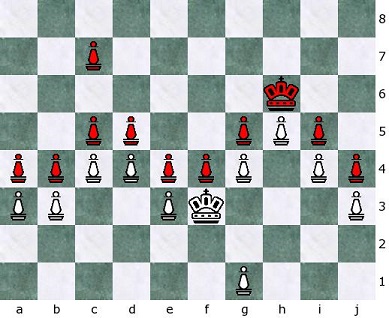
Diagram 18 - Sample blocked position
This is another type of situation that may occur in the classical Latrunculi, as well as in Latrunculi XX1 (even with the 3 new rules and tactics above). In order not to affect their positions, both players could move their free pawns at c7 and g1 almost indefinitely, and with so many squares available to each of the soldiers, it would take a long time before the game ended by means of the Threefold Repetition rule.
Positions like the above one inspired a new set of tactics called Charging Attacks. These new attacks allow the capture of soldiers to be achieved by means other than custodial attacks.
The list of Charging Attacks include:
- Pushing and crushing enemy soldiers in the same direction of the attack.
- Flank attacks, which sandwich multiple enemy soldiers between two soldiers.
- Phalanx attack
Tactic #2 - The Push and Crush
- Rule #13 - A piece can charge to push a single friendly piece and crush an enemy soldier against the Walls of the City or against another friendly piece, to accomplish the capture of the enemy soldier.
Lets split this rule in two two separate parts with examples:
- Rule #13a - A piece can charge to push and crush an enemy soldier against the Walls of the City, to accomplish the latter's capture. To perform this tactic, a piece has to charge to and push another (and only ONE) friendly piece to crush the enemy soldier against the Wall. The push has to be in the same orthogonal direction of the two soldiers locked in combat and the crush has to be against an edge of the board. Note: Duxes can participate offensively in this tactic, however a Dux cannot be captured by this rule.

Diagram 19 - Sample push and crush attack against the wall
Look at the same barricaded position as before (above left) and note the white g4 soldier. According to rule 10, the g4-soldier (who is locked in a melee) normally could not move. However rule 13a defines a new offensive capture type, and rule 11 enables the soldier to move offensively to h4 to push his partner at i4 to crush the black j4-soldier against the Wall. After this move (g4-h4xj4) the black soldier is removed from the board.
Note however that should the white h5-soldier move to h4, this would not result in the capture of the j4-soldier, for the moving h4-soldier is not moving in the same direction of the i4 vs j4 combat, and therefore the move h5-h4 is not considered to be a push and crush. Since this move (h5-h4) is not considered an offensive move, the h5-soldier actually cannot even move due to rule 10. While the h4-soldier would be free to abandon his combats against black's g5 and i5 soldiers (by rule 12), the h4-soldier cannot abandon his one-on-one fight against the Black Dux, as there wouldn't be any other white piece left still fighting the Dux after the h5-soldier move.
- Rule #13b - A piece can charge to push and crush a sandwiched-in enemy soldier, to accomplish the latter's capture. To perform this tactic, a piece has to charge and push another (and only ONE) friendly piece to crush the enemy soldier against a 2nd friendly piece. The push has to be in the same orthogonal direction of the three soldiers engaged in the sandwiched position. The crush is completed when the enemy soldier is pushed onto the weapons of the friendly soldier at his back. Note: Duxes can participate offensively in this tactic, however a Dux cannot be captured by this rule.

Diagram 20 - Sample push and crush attack against another friendly piece
Lets return to the same barricaded position as before (above left) and this time note the black d5-soldier. According to rule 10, the black d5-soldier (who is locked in a skirmish with the white d4-pawn) normally could not move. However rule 13b expands the push and crush tactic, and rule 11 enables the soldier to move offensively from d5 to f5 to push his partner at g5 to crush the black h5-soldier against the friendly weapons of the i5-soldier. After this move (d5-f5xh5) the white soldier is removed from the board.
Look at the position below where two different tactics are combined to perform two captures at once:
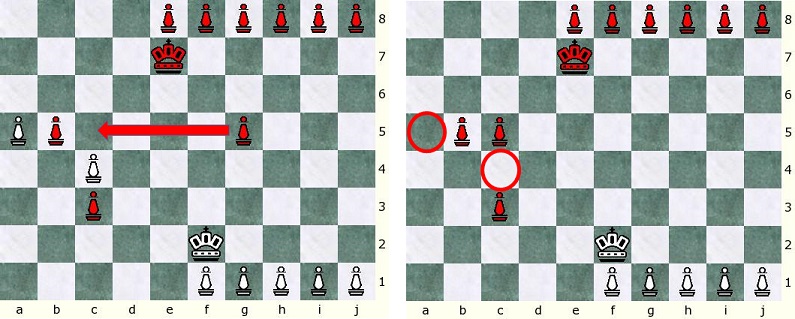
Diagram 21 - Black plays g5-c5xa5xc4, a push and crush attack and a custodial capture
Tactic #3 - The Flank Attack
- Rule #14 - The enemy soldier in the rear of a linear defensive formation can be captured by means of a charging flank attack. The way this tactic works is simple: a friendly piece launches an attack by charging onto the back (and in the same direction) of a linear enemy formation, sandwiching-in any number of enemy pieces (2, 3 or more) between two friendly troops, thrusting his sword into the soldier in the rear and causing the latter's capture.

Diagram 22 - Sample flank attack
Lets return this position. Look at the two-on-one linear formation made by the d4-e4-f4 soldiers. The two soldiers at d4 and e4 are in a one-to-one combat. The black f4-soldier is defending the back of his e4-partner from a custodial attack by the white Dux. However this defender falls victim to the h4-g4xf4 flank attack.
Note again however (similar to the case for rule 13) that should the white g1-soldier move to g4, this would not result in the capture of the f4-soldier, for the moving g1-soldier is not moving in the same direction of the d4-e4-f4 two-on-one linear formation, and therefore the move g1-g4 is not considered to be a flank attack.
The flank attack will look a bit familiar to classical Latrunculi players, for in one of the reconstructed rules to the classical game, this same move would result in the capture of both of the black e4 and f4 soldiers sandwiched between the white soldiers. In my humble opinion, this classical capture of multiple (2 or more...) soldiers sandwiched together does not make sense in a battle context, and that's why I consider the flank attack to be an improvement in Latrunculi XXI.
The object of the directional attacks in rules 13 and 14 is simple: to force the collapse of the barricaded position. These new tactics should encourage both players to fight for a win, instead of cowardly moving their free men in barricaded positions into a drawish situation.

Diagram 23 - Several flank attack examples
Every red arrow represents a valid charging flank attack resulting in a capture. The yellow arrows represent moves that do not result in capture.
Valid Captures: b8-d8xe8, j8-i8xh8, f5-d5xc5, h7-h5xh4 and j2-j3xj4
Valid moves, but without captures: d1-d5, d1-d8 and f5-h5
Illegal move: h3-j3 (since this move doesn't result in a capture, because of rule 10, this move is actually illegal)
Tactic #4 - Testudo and Phalanx formations
- Definition 3 - A Testudo is a solid defensive formation that is square or rectangular in nature, which is very strong and hard to break. However, just like their Roman historical counterparts, Testudo formations were the weakest on their flanks, and likewise in Latrunculi XXI, a Testudo formation can be broken by a charging flank attack, as was demonstrated in the previous diagram with j8-i8xh8 and f5-d5xc5.
Testudo formations are always square/rectangular in nature, and include any number of soldiers, as long as the shape is square or rectangular.
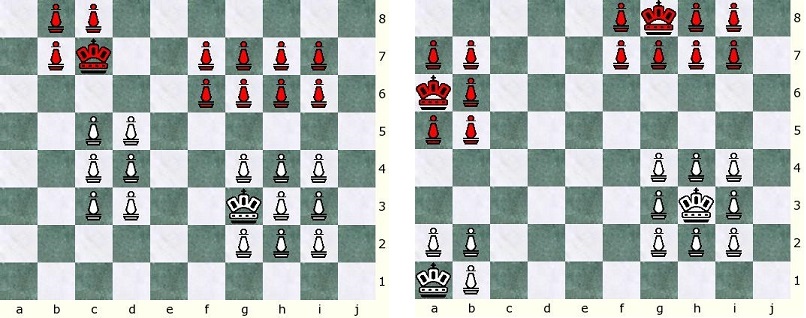
Diagram 24 - Sample legal Testudo formations (left), and illegal Testudo formations (right)
None of the formations on the right diagram above are legal. As per rule 1c, under no circumstances a Dux can be surrounded exclusively by his own men, without the Dux having an open adjacent orthogonal square. In all these formations the Dux is demonstrating the cowardice not allowed in the Roman Empire.
- Definition 4 - A Phalanx, just like it's Greek historical counterpart, is an offensive formation, that looks similar to the defensive Testudo. Look at some sample Phalanx formations below:

Diagram 25 - Sample Phalanx attacks
- Rule 15 - A Phalanx is a charging attack whereby the Phalanx turns into a Testudo and causes the capture of a soldier in the same orthogonal line (row or flank) and the same direction, but on the other side of the Testudo. Note: Duxes can participate offensively in this tactic, however a Dux cannot be captured by this rule.
Look at the black 5-men Phalanx formation at c7-d7-e7-e6-d6. It looks like an incomplete Testudo. The a6-soldier can play to c6 (therefore completing a Testudo) causes a directional attack that pushes, crushes and captures the white f6-soldier. Similarly, the when the white i1-soldier moves to i4 to join the directional Phalanx attack, it captures the i6-soldier.
On the other hand the Phalanx attack on the Dux at e2 fails, as Duxes can only be captured by immobilization.
The Dux Rules
This table summarizes the Dux mobility rules:
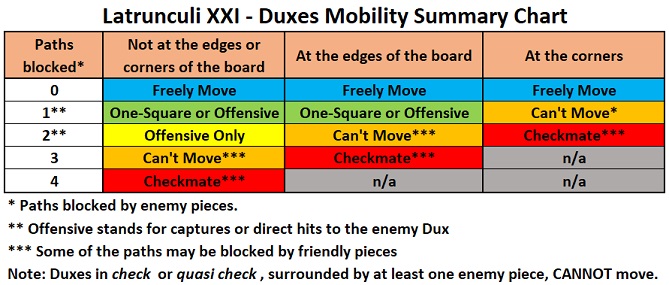
As you can see, Duxes are the most vulnerable at the corners of the board, where they have the least mobility and can be partially-immobilized by just one enemy soldier.
Duxes have the most mobility options while in the inner board (away from the Walls of the City).
Definition 5 - In Latrunculi XXI, a "quasi check" is defined as a partial-immobilization where a Dux is orthogonally surrounded by pieces (either friendly, enemy or a combination of both) in such a way that the Dux only has ONE (and oly one) open path. Therefore a Dux in a quasi check is one adjacent blocked path away from immobilization (the Roman smothered checkmate), but it is NOT in check (see definition 6 below).

Diagram 26 - Sample Duxes in quasi checks- Each one of the Duxes in the diagram above is in a quasi check. They all have one orthogonal path still open, and are one blocked path away from full-immobilization (checkmate), but none of them are in check, as there isn't a threat of immobilization on the next move for any of them.
- The Duxes at a1, a6, d3 and e8 are partially immobilized in some sort of a combat against at least one enemy pieces and (by rule 17 below) they cannot move.
- Even though the Duxes at g1, h5 and j8 are quasi checked, since they are only surrounded by friendly pieces, (by corollary 17i below) they can still move in the path of their only open direction.
Definition 6 - In Latrunculi XXI, similar to Chess, a "check" is defined as an attack that creates an actual threat of immobilization in the next move. It's legal for a player in check to ignore (sometimes wisely) the check and play somewhere else, even if he/she was to be checkmated after his/her opponent's next move.
There is no formal mandate for a player to say "check" or to warn the other player when the opponent's Dux is going to be immobilized on the next move.
However, similar to Chess, players are encouraged to call "check" when placing their opponent in a situation where the next move will be checkmate.
Here are two sample checks from real play:

Diagram 27 - Positions after 14.f1-f2+ (left) [J. Carrillo vs C. Cetina, Jul 2016] and after 13.b1-d1+ (right) [J. Joyce vs J. Carrillo, Aug 2016]
On the left, White's move partially-immobilizes the enemy Dux and discovers a check (mate threat is 15.d4-f4#).
On the right, White moves and checks by threatening the previously partially-immobilized (i.e. quasi checked) Dux (mate threat is 14.d1-d5#).
In Latrunculi XXI, all checks result in the partial-immobilization of the enemy Dux. But not all partial-immobilizations are a result of check (some of the former are the result of quasi checks).
The fact that a player in check may ignore the check and play somewhere else, would probably not usually make sense to a chess player, but the example below will make the concept perfectly clear:
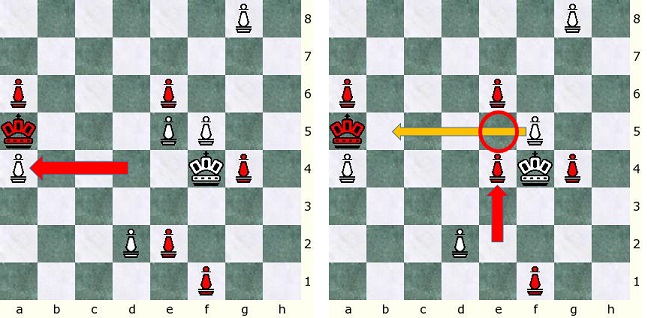
Diagram 28 - Position (left) after d4-a4+!! and (right) after ... e2-e4xe5+??
In the position on the left, white threatens mate with e5-b5#. On the position on the right, black captures the white e5 soldier, and he/she also gives check to the white Dux (the mate threat is f1-f3#).
Just because white is in check, it doesn't mean that white needs to defend or protect his Dux (i.e. d2-d4xe4).
White simply ignores the check on his own Dux and plays f5-b5#, checkmate! Game's over.
It also is possible for a player to move (not wisely) and place his/her own Dux in check.

Diagram 29 - Sample immobilized Duxes (left) and Dux mobility examples (right)
The diagram on the left above shows different immobilized Duxes.
However without some sort of rules to limit the mobility of Duxes none of these positions would be achievable without a player missing the fact that his/her Dux was one move away from being immobilized.
The Dux at e6 in the diagram on the right above is free to move anywhere orthogonally along the path of the yellow arrows. There are no restrictions for this Dux to move, as his path is not blocked, nor he is engaged in a combat with an enemy soldier.
Likewise, according to rule 12, the Dux at i7 is free to move anywhere orthogonally along the path of the purple arrows. Even though this Dux is in combat with the enemy j7-soldier, when the Dux moves, the j7-soldier will remain in combat with the j8-soldier, therefore it is perfectly legal for the i7-Dux to move.
The following rules limit the ability of the Dux to move when he is in engaged in combat:
Rule 16 - A Dux in a one-on-one combat with a single enemy piece can ONLY move non-offensively one square orthogonally. The Dux at b7 in the diagram on the right above illustrates this rule. The Dux is in combat with the white b8-soldier, therefore he can only play to either a7 or b6. (not to c7 which is occupied by a friendly soldier)
Rule 17 - A Dux in a two-on-one combat against two enemy pieces can ONLY make offensive moves. The Dux at d2 in the diagram on the right above illustrates this rule. The Dux is in combat with the black c2 and d1 soldiers, therefore he cannot move defensively to escape his current post.
The Dux at b4 in the diagram on the right above illustrates this rule. Similar to the Dux at d2, the black b4-Dux cannot freely move anywhere but to h4 (along the black arrow), as this move hits (rule 18) an enemy Dux and actually checkmates it!.
Rule 18 - A Dux that is partially-immobilized (i.e. ONLY one orthogonal adjacent square open) cannot make any moves at all. The Dux at i4 in the diagram on the right above illustrates this rule. The Dux is in combat with the black i5-soldier and his own soldiers are blocking two of his escape paths. Therefore this Dux has no legal moves.
The following corollary is not really a rule, but a point of clarification to rule 18.
Corollary 18i - A Dux that is surrounded exclusively by friendly forces with only one direction left open, is still in check, however it can still move freely. The Dux at g2 in the diagram on the right above illustrates this rule. The Dux is not in combat, but his path is blocked by his own friendly forces in three other directions. Even though he is still in "check" (one move away from being immobilized) this Dux is free to move anywhere in the open direction (along the blue arrow).
You may have noticed that some of the rules (#s 10, 16 and 17) make reference to non-offensive moves. So far the only type of offensive move is one that results in a capture: custodial captures, corner captures, push and crush attacks, flank attack and the Phalanx attack.
Rule 19 - A move that hits the enemy Dux is always considered as an offensive move. Rule 19 allows moves to be played, beyond those restricted by rules 10, 16 and 17; as long as the move directly hits the enemy Dux. (Note: Rule 19 does not have any impact on Rule 18. Even if a partially-immobilized Dux has the possibility of hitting an enemy Dux, it cannot move).
The following diagram illustrates Rule 19:

Diagram 30 - Sample offensive hits on the Duxes- Under rule 10, the white b3-soldier cannot move. However, rule 19 allows b3-d3*, with a hit to the enemy Dux.
- Likewise for the black j3-soldier, rule 19 allows it to move j3-j5+ (note that this time the '+' mark is used, as the White Dux would be in check with only one open direction.
- Rule 16 allows the white j6-Dux to move one square to either i6 or j5. Rule 19 allows it to move also to b6 immobilizing the a6-Dux: Dj6-b6#.
- Likewise, according to rule 16, the black e3-Dux can move to either d3 or e4; rule 19 allows it to move to e6, also partially-immobilizing the enemy: De3-e6+ (leaving him only one open side)
- Under rule 16, the white e7-Dux cannot move. Rule 19 allows it to move and hit the black e3-Dux: De7-e3*
- According to Rule 18, the black a6-Dux cannot move (for it is in 'check' with only open side). Rule 19 does not have any effect over rule 18, therefore the a6-Dux cannot move (even though it could have potentially hit the enemy Dux at j6).
Rule 20 - A capture precedes a self-immobilization. This rule is important because if the order was reversed then, in some cases, a self-immobilization would occur where a valid capture should take place, and self-immobilizations are illegal in Latrunculi XXI (see rule 1c).
This rule is similar to how stones in the Japanese game of Go are allowed to play into what would be an otherwise an illegal suicide position, if the play forces the immediate capture of (any number of) enemy stones without any liberties.
The following diagrams illustrates Rule 20:

Diagram 31 - Sample situations where the fact that a capture has precedence prevents self-immobilization- Phallanx Attack (rule 15): h1-h3xh5(+) - White's Dux is partially immobilized, but with the Phallanx attack he captures the h5-pawn, which opens up a new path for the Dux to move. White's Dux remains partially immobilized.
- Push and Crush against the Wall (rule 13a): b6-b3xb1(+) - Black's Dux is partially immobilized, but with the Push and Crush against the Wall he captures the b1-pawn, which opens up a new path for the Dux to move. Black's Dux remains partially immobilized.
- Push and Crush against a friendly soldier (rule 13b): b6-d6xf6(+) - Black's Dux is partially immobilized, but with the Push and Crush against the the friendly soldier at g6, Black captures the f6-pawn, which opens up a new path for the Dux to move. Black's Dux remains partially immobilized.
- A Phallanx attack example from real play: Position after 17.j3-e3(+) [J. Carrillo vs N. Wolff, Jan 2018]. Under rule 20, Black can legally play 17... h4-f4xd4?? However this move would be a blunder, as Black's Dux (who is currently in a quasi-check) would remain in a quasi-check after the capture, and 18.d5-d4# (breaking the lock is allowed by Rule 19) would be checkmate and end the game.
It does not matter that temporarily the Duxes do not have any open paths; after the execution of the moves and captures above, a new path gets opened, leaving a legal position. - Rule 15 - A Phalanx is a charging attack whereby the Phalanx turns into a Testudo and causes the capture of a soldier in the same orthogonal line (row or flank) and the same direction, but on the other side of the Testudo. Note: Duxes can participate offensively in this tactic, however a Dux cannot be captured by this rule.
Notes
Below is a Latrunculi XXI setup, on a Capablanca 10x8 board. The Rooks on the outside of the corners of the board have no real significance (other than trying to weight down the vinyl board, to serve as the Towers of the City [the board], and as a reminder that all pieces move like Rooks).
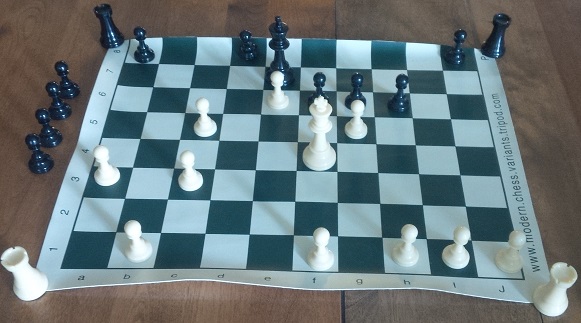
Diagram 32 - Position after 10.Df5-f4 - Jose Carrillo vs Joe Joyce, CV Game Courier, July 2016
Game Notation
Given that all soldiers move the same way, long algrebraic notation is used to record the moves in Latrunculi XXI; because it may become confusing from where a soldier may have come from, to a particular square when recording a game; as potentially multiple soldiers can play to the same squares. Like for Pawns in Chess, Soldier moves do not need to have the initial (S) preceding the move. Only Dux moves need to carry the initial (D) in front of the move.
A move that threatens immobilization of a Dux carries the '+' sign (just like a check in chess), and a move that immobilizes and wins the game carries the '#' sign (just like a checkmate in chess).
Another symbol that is used in Latrunculi XXI is the '*', which represents a move that hits the enemy Dux (blocks one of his open orthogonal paths).
Another play that gets it's own symbol is the quasi check. If the move that hits the enemy Dux also partially-immobilises him, but does NOT place him in check, the "(+)" combination [including the parenthesis] is added to the end of the move.
If the move that hits the enemy Dux also puts him in "quasi check", "check" or "checkmate", the '(+)', '+' or "#" symbols are used by themselves, without using the '*'.
Therefore the notation for each move is: [D or blank][from square]-[to square](x captured piece square)[*, (+), + or #]
In Latrunculi XXI the terms immobilization threat and immobilization can be replaced by the common chess terms check and checkmate (or simply mate). To smother is also synonymous with to immobilize.

Diagram 33 - Sample Latrunculi XXI annotated moves:
- c8-c6xb6*
- d3-b3
- e2-e6+ (immobilization threat: d8-d7#)
- g3-g5*
- g2-i2#
Additional traditional Chess notation symbols can also be added to indicate the quality of the moves or the result of the game when annotating Latrunculi Games. (!, ?, !?, ?!, !!, ??, 1-0, 0-1, ½-½ )
Â
Â
Latrunculi XXI tactics for Chess Players
Â
Â
-
Melees
Here is an illustration of rule 12 from real play:

Diagram 34 - Position after 9.i8-d8 [Jose Carrillo vs Joe Joyce, July 2016]
Look at the four-piece melee above. It's composed of two smaller two-on-one melees (Dux at e7 plus e6 and e7 soldiers, and the same two soldiers with the Dux at f5). Focus on the white soldier at e6. It is in combat with the black Dux at e7 and also with an enemy soldier at f7. Even though the white soldier's attack on the enemy soldier is supported by another attack by the white Dux on the same black f7 soldier, the white soldier cannot move because if it moved, it would be fleeing away from his fight with the black Dux (rule 10) and that's illegal.
Now look at the white Dux at f5. Likewise, it is in combat with the black soldier at f6. According to rule 12, the Dux can move anywhere in the path of the yellow arrows, because when it moves, the enemy soldier at f6 will still remain in combat with the white e6 soldier.
Using the same logic; if it was black's turn to play, his/her f6 soldier could not move and flee out of the melee (rule 10), but the black Dux would be free to move anywhere within it's reach (rule 12).
Here is another example demonstrating Rules 10, 11 and 12:

Diagram 35 - Sample melees
There are two simple soldier combat melees, and two complex ones;
Simple melees:- i6-i5-j5 trio:
- The white i5-soldier cannot move freely (rule 10), but it can still perform the i5-f5xf4 capture (rule 11).
- Either one of the black soldiers can move (rule 12)
- a1-b2-c1-b1 group:
- The black b1-soldier cannot move (rule 10, and because of the obvious, it's immobilized).
- Either one of the three white soldiers can move (rule 12)
- a6-a5-b5-b4 group:
- Both white a6 and black b4 soldiers are able to move (rule 12).
- The white b5 soldier is engaged in a two-on-one combat against the a5-soldier, and in a one-on-one combat against the b4-soldier. Rule 12 would allow him to move as it regards to the b4-enemy, but rule 10 doesn't allow him to move as it regards to the b4-soldier. Conclusion: The white b5-soldier cannot move.
- The black a5-soldier is in the same sort of predicament as the white b5-soldier, and should not be able to move. However rule 11 allows it to make its only legal move, an offensive capture at the corner: a5-a2xa1
- e6-e5-e4-f4-f3-f2-g2 group:
- Rule 12 allows these soldiers to move freely: e6, e4, f4, f3 and g2
- Rule 10 prevents these soldiers from moving : f2
- Rule 11 allows the following captures: e5-c5xb5 and e5-h5xi5, otherwise the black e5-soldier cannot move non-offensively (rule 10).
- i6-i5-j5 trio:
-
Capture Threats
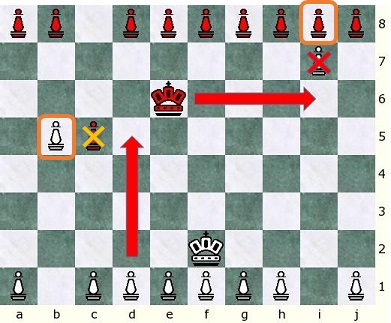
Diagram 36 - Direct and passive threats
Every capture threat is made of two individual component threats:
- Direct threat: by the piece will move to complete the capture, or hit on the Dux.
- Passive threat: by the static piece(s) that are already in place, setting up the capture.
In the diagram above, the d1-soldier and the e6-Dux have direct threats; while the b5 and i8 soldiers have passive threats, on the c5 and i7 soldiers respectively.
It is possible for a piece to have dual threat roles, having a passive threat on an adjacent piece, and a direct threat somewhere else on the board.
- Direct threat: by the piece will move to complete the capture, or hit on the Dux.
-
Self-Check

Diagram 37 - Position after 6.e1-e5 [Jose Carrillo vs Joe Joyce, July 2016]
White partially-immobilizes himself by covering his Dux' 3rd side, to create a custodial capture threat on the black d5-soldier. There is no immediate risk for black to immobilize (checkmate) the white Dux, because black cannot reach the f4-square in one move.
-
Double Attack

Diagram 38 - Double attack by white's d5-soldier
The white d5-soldier has the following threats:- d5-b5# immobilizing the black Dux and winning the game
- d5-f5xh5xf6 (a dual capture by Phalanx Attack and Custodial Attack)
As a consequence of the double attack by the d5-soldier (and black's almost forced response to move his a6-soldier), white captures both of black's f6 and h5 soldiers with his next move: d5-f5xh5xf6
-
Fork
A fork is a type of double attack. There are three types of forks in Latrunculi XXI:- Direct Fork - It occurs when a piece itself is directly threatening the capture of two (or more) enemy pieces.
- Passive Fork - It occurs when a piece moves adjacent to two (or three) enemy pieces, and creates separate capture threats on multiple adjacent enemy pieces.
- Comrades' Fork - It occurs when two (or more) pieces have dual threat roles, which working along with another piece(s) [the comrades], create a combination of concurrent direct and passive threats on multiple enemy pieces.
Look at examples of the first two types of forks from real play:
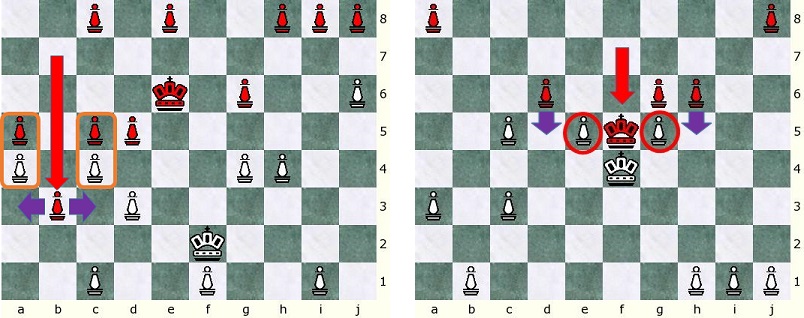
Diagram 39 - Positions after 9...b7-b3 (left) [Nathan vs Carrillo, August 2016]; and after 13...Df7-f5* (right) [Carrillo vs Joyce, July 2016]
On the right, Black safely quasi checks himself to create a passive fork on white's e5 and f5 soldiers. White can only protect one of two soldiers, and the other one will fall. (The game proceeded with: 14.e5-e8 h6-h5xg5)
Now look at a comrades' fork from real play:

Diagram 40 - Comrades' fork. Position after 5... e6-b6 [Joe Joyce vs Jose Carrillo, August 2016]
Black moves the soldier to b6 (red arrow) and together with his comrade (the Dux at e4), they create both direct and passive threats on each of the white e5 and b5 soldiers (purple arrows). Regardless of what White plays, one of the two soldiers will fall.
- Direct Fork - It occurs when a piece itself is directly threatening the capture of two (or more) enemy pieces.
-
Pin

Diagram 41 - Pin on the white c5-soldier
The white c5-soldier is fighting in a combat and therefore has only the following legal moves: c5-c7* and c5-c4xc3 (rules 19 and 11; hitting the enemy Dux and to capture). Black however has a pin on the white c5-soldier, for after either one of the two white moves above, Black wins the game with b5-f5#.
All pins are relative in Latrunculi XXI. Any pin can be broken even if breaking it would result in the loss of the game.
-
Skewer

Diagram 42 - Skewer after c7-c4 on white's Dux at f4
The white Dux is preventing the dual capture of the f5 and g4 soldiers, however at the same time he is in the risk of partial immobilization (check) by either c4-e4+ or Df1-f3+, bringing him one move away from checkmate.
White needs to move his/her Dux to protect from the check, and black will capture both soldiers with either c4-f4xf5xg4 or Df1-f4xf5xg4.
-
Dual Capture

Diagram 43 - Dual capture attack by black's h3-soldier: 13... h3-g3xf3xh4 (two Custodial Captures) [Arx vs Jose Carrillo, December 2016]
Any of the offensive attacks (custodial attack, corner attack, push and crush, flank attack and Phalanx) can be combined in a single move with another custodial attack to accomplish a dual capture, as in the following example:

Diagram 44 - Dual capture attack by white's e1-soldier: 7. e1-e4xe6xd4 (Phallanx Attack and Custodial Capture) [Jose Carrillo vs Per Hommerberg, September 2017]
-
Locked Soldiers
Forcing multiple skirmishes, thereby locking Soldiers is a tactic especially useful later in the endgame, when there are fewer pieces on the board, and one player manages to disable his/her opponent from moving, achieving a win by stalemate.
This position comes from the sister-game Single Stone Latrunculi XXI:
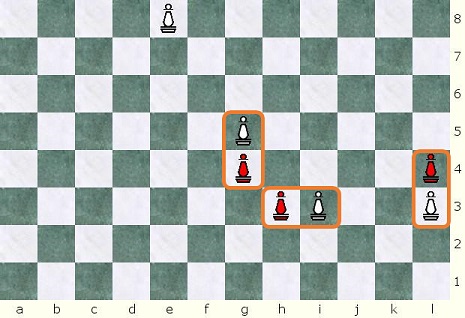
Diagram 45 - Position after 31.i7-i3! 1-0 [Jose Carrillo vs Jan Kutac, October 2017]
There are 3 pairs of black soldiers locked in seperate skirmishes. Since neither of the black soldiers is able to move, it's a stalemate and a win for white.
-
Discovered Check

Diagram 46 - Discovered check positions after: f1-f2+ (left) and d1-d5+ (right).
In Latrunculi XXI, a discovered check occurs when the movement of a piece exposes the enemy King to the threat of immobilization by another friendly piece.
In the diagram above, the purple arrows represent the discovered checkmate threats: d4-f4# (left) and g4-e4# (right).
-
Mating Net

Diagram 47 - Mating net. Position after 16... g8-g5(+)!! [Joe Joyce vs Jose Carrillo, August 2016]
Black's move quasi checks and creates a mating net around the white Dux. It's now mate in 2.
X marks the spot where Black will close the mating net after he plays either 17...e3-f3+ or 17... h5-h4+.
White can stop one of the threats (i.e. 17.h1-h4), but not both.
Note: White cannot block checkmate by playing to f4 (i.e. 17...e3-f3+ 18. e4-f4??) because he would immobilize his own Dux, and that's illegal (rule 1c).
-
Zugzwang
This position comes from the sister-game Single Stone Latrunculi XXI:

Diagram 48 - Zugzwang. Position (left) after 30.i3-l3!! [Jose Carrillo vs Jan Kutac, October 2017]
Black is down in material, and is put at a worse disadvantage by been forced to make a move with his g3-soldier, a Zugzwang position. Black's other g4 and l4 soldiers are locked in separate skirmishes and cannot move.
White threatens 31.g5-l5xl4 and 31.l3-g3xg4 (as Black is forced to move his g3-soldier). Both threats would give white an even bigger material (and winning) advantage in this contest.
Black played 30... g3-h3?! and after white's 31.i7-i3! 1-0 (position on right), black's last remaining soldier is now locked in a skirmish as well.
Without any legal moves, black is stalemated and loses the game. -
Zwischenzug

Diagram 49 - Zwischenzug. Position after 16.g4-e4(+) g8-g5(+)!! [Joe Joyce vs Jose Carrillo, August 2016]
White quasi checks the black Dux. White's follow up moves would be 17.a1-a6+ and 18.a6-e6#.
Instead of directly countering White's threat (i.e. 16... a8-a2), Black introduces an even more devastating threat, by attacking and giving a quasi check of his own, and threatening mate to the white Dux in 2 moves.
After 16... g8-g5(+)!!, White finds himself inside of a mating net and will surrender to either 17...e3-f3+ or 17... h5-h4+.
White is forced to abandon his earlier attack (17.a1-a6+), and is unable to recover from Black's Zwischenzug.
The game ended with: 17.i1-i2?! h5-h4+! [mate in 1] 18.i2-i4 h4-f4# mate! 0-1
Here's another Zwischenzug position that comes from the sister-game Petteia XXI:

Diagram 50 - Zwischenzug. Position after 27...f8-d8 28.f3-f4! [Jose Carrillo vs Jan Kutac, November 2017]
Black has given for lost his k5-soldier (which is locked and under the Phallanx attack threat 28.k2-k3xk5), so he focuses on capturing white's d4-soldier with a Phallanx atack of his own (with 28...d6-d5 followed by 29...d8-d6xd5).
White detects the threat to his d4-soldier, and instead of relocating it or executing the Phallanx attack that will capture black's k5-soldier, he plays the intermediate move: 28.f3-f4!, Zwischenzug.
Now white locks black's f5-soldier and creates a new Phallanx threat (when combined with 29.l1-f1), which will result in white winning the exhange as he will get both of black's f5 and k5 pawns, for the cost of his d4-pawn. A well worth sacrifice.
Â
Miscellaneous
Â
-
Is the classical Roman game of Latrunculi a Chess Variant?
There are people who actually believe that Latrunculi may have had some influence in the development of Shatranj (and therefore Chess), because of the introduction of Latrunculi to Persia by the Roman armies during the Roman-Persian wars (between the 1st century BC and the 7th AD). Others however believe that it was because of the introduction of Shatranj to the Romans during the same period, that Latrunculi's popularity in the Roman Empire waned in favour of the new chess-like game. The jury is still out on this one.
Russian Chess GM Yuri Averbakh goes further back in time, to the Greek-Indian period (3rd century BC) post the invasion by Alexander the Great of northeastern India, and ties the influence of Latrunculi's ancestor: Petteia, to the most important event in the development of Chaturanga into a chess-like variant: discarding the dice, to turn the game on the ashtapada from a race game, into a military game based on pure reason. (A History of Chess from Chaturanga to the Present Day, December 2012)
-
Is Latrunculi XXI harder to play that Chess?
Difficulty is relative...
But if you consider that Chess has 6 different kinds of pieces each with different types of moves, including some arbitrary rules to speed the game up (i.e. 2-step initial pawn moves, en passant and castling) and compare it with Latrunculi XXI which only has an army of 2 different type of pieces, all of them moving the same way (i.e. as Chess Rooks) and all with multiple (but common to all pieces) ways to perform captures; suddenly Latrunculi XXI doesn't seem so hard to play.
There is no doubt that there is a slight learning curve, but playing the game is simple, what may feel hard is that it takes sometime and practice to grasp the different ways pieces can setup their capture opportunities. -
Inspiration for Latrunculi XXI's locked "pawns"
The idea behind rules 10 (block or lock) and 11 (move to capture) is actually inspired from chess. Look at this two diagrams:

Diagram 51 - Chess' blocked pawns and Latrunculi XXI's locked soldiers
Note the two pawns in the chess board at h4 and h5. These two pawns are blocking each other's path, and therefore cannot move. Similarly the two soldiers (or pawns) in the Latrunculi board at j4 and j5 are locked in a combat with each other, and likewise cannot move (rule 10).
Now look at the two pawns in the chess board at b4 and b5. They are also blocking each other and cannot move forward, however the white b4-pawn is still able to move to perform a capture: b4xc5. This move removes the blockage and frees the black b5-pawn, who will be able to move in the next move.
Similarly, in the Latrunculi board, the soldiers at b4 and b5 are locked in a combat, and cannot move (rule 10). However (just like in the chess board) the white b4-soldier is still able to move to perform a capture: b4-e4xf4 (rule 11). This move ends the combat and frees the black b5-soldier (just like in chess), who will be able to move in the next move.
-
Inspiration for Latrunculi XXI's Rule 20: A capture precedes a self-immobilization.
This rule is similar to how stones in the Japanese game of Go are allowed to play into what would be an otherwise an illegal suicide position, if the play forces the immediate capture of (any number of) enemy stones without any liberties. Look at this two diagrams:
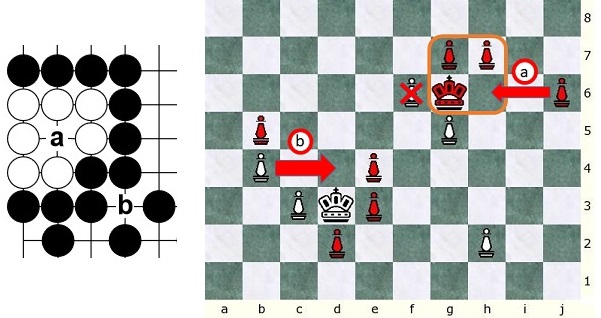
Diagram 52 - Legal moves (a) where Black forces captures in both Go and Latrunculi positions; and illegal moves (b) where White cannot prevent a suicide (in Go) or a self-immobilization (in Latrunculi)
Move a is legal in both Go and Latrunculi positions, for the Black moves would cause the capture of the enemy pieces PRIOR to the suicide (in Go) or the self-immobilization (in Latrunculi) taking place.
Move b on the other hand is illegal in both Go and Latrunculi positions, as the White moves do not force any captures that that would otherwise prevent a suicide of the piece played (in Go) or a self-immobilization in Latrunculi.
-
Latrunculi XXI versions of the Fool's Mate
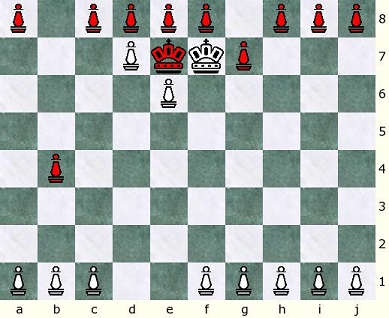
Diagram 53 - Sample Fool's Mate: 1.e1-e6* b8-b4 2.Df2-f7+ g8-g7(+)?? 3.d1-d7#
Named after its Chess counterpart, a Fool's Mate (technically a Fool's Immobilization) is the immobilization of the enemy Dux in the fewest possible number of moves from the start of the game. The example above accomplishes it in 3 moves. The one below takes 2 moves.
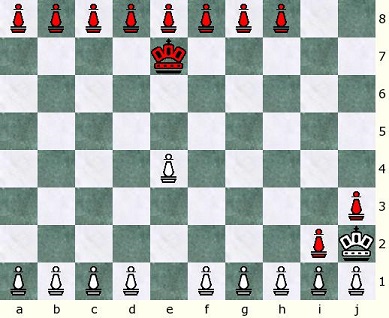
Diagram 54 - Two-moves Fool's Mate: 1.Df2-j2? j8-j3+ 2.e1-e4?? i8-i2#
A Fool's Mate can only occur if a player plays extraordinarily foolishly, therefore this type of immobilization almost never occurs in practice.
-
Phalanx Attack vs Fortress formation
A Fortress formation is a solid defensive stance (usually in a corner or edge of the board) where a Dux barricades itself behind his soldiers, but where the Dux still has a few squares to move freely within the formation.
Below is a Fortress formation that neither the push and crush or the flank attack tactics would be able to break.

Diagram 55 - Phalanx attack versus defensive Fortress formation
White has barricaded himself against a corner of the City. Being able to move the Dux, and the h2 and j1 soldiers inside of this fortress, white could stand the siege of the black forces for a while, before the the Threefold Repetition rule kicked in and white lost due his cowardice.
The directional Phalanx attack completed by a1-e1xg1 crushes and captures white's g1-soldier enabling black to begin to the destruction of white's fortress, which will enable black to put white out of his misery much faster than by the Threefold Repetition rule.
Note that after the Phalanx directional attack (completed by moving the soldier from a1 to e1), the e1-soldier is now part of a Testudo formation (e2-f2-f1-e1). -
Common Latrunculi XXI formations

Diagram 56 - Common Latrunculi XXI formations- The soldiers at a1-b1 are locked fighting in a combat, specifically a one-on-one combat
- The soldiers at a5-a6-b6 are in a two-on-one melee
- The soldiers at e8-f8-g8-h8 are in a linear defensive formation.
- The pieces at j3-j4-j5 (including the Dux) is also a linear defensive formation.
- The white defensive formation at d2-d3-e3-e2 is called a Testudo.
- The black offensive formation at g6-h6-h5 including the moving soldier at e5 is called a Phalanx.
- The soldier at a3 has two capture options: a custodial capture at a4, or a corner capture at a2.
Â
Sample Complete Latrunculi XXI Games
- Latrunculi XXI
Jose Carrillo (CAN) - Carlos Cetina (MEX)
CV Game Courier, July 2016
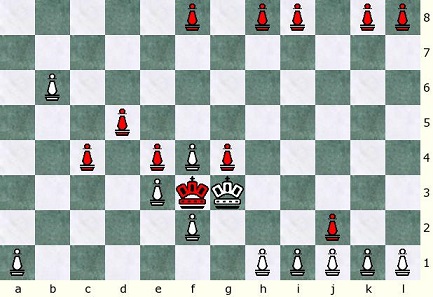
1.d1-d4 d8-d5 2.c1-c6 e8-e6 3.Dg2-g6 c8-d8?! 4.c6-d6xd5 Df7-f6* 5. Dg6-g5 a8-a6 6.b1-b6! b8-c8 7.d6-c6xa6 Df6-f5* 8.e1-e5*? d8-d5xe5 9.f1-e1 Df5-f2?! (Black's last move is illegal [rule 16], but both players missed it) 10.e1-e2* Df2-f3 11.e2-e3* g8-g6* 12.Dg5-g3* g6-g4* 13.g1-f1 j8-j2!? (14.Dg3-j3xj2 Df3-i3*) 14.f1-f2+ (15.d4-f4#) e6-e4 15.c6-f6+? (better: 15.c6-d6xd5) c8-c4xd4?! (better: 15... d5-f5! [rule 12], followed by 16... f8-f7xf6) 16.f6-f4# 1-0
- Latrunculi XXI
Jose Carrillo (CAN) - Joe Joyce (USA)
CV Game Courier, July 2016
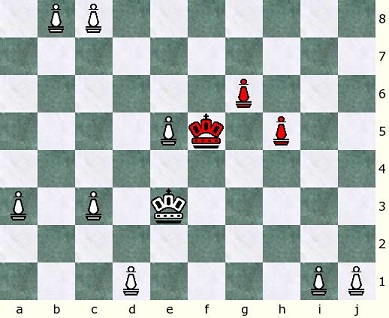
1.g1-g5 b8-b3 2.a1-a3 c8-c2? 3.d1-d3 d8-d5 4.d3-c3xb3xc2 e8-b8 5.Df2-f5 f8-f6* 6.e1-e5(+) b8-b3? 7.c3-c5xd5 g8-g6 8.e5-e6* h8-h6 9.c1-c3xb3 i8-d8 10.Df5-f4 d8-d6xe6 11.f1-e1 De7-f7 12.e1-e6 f6-f5*?! 13.e6-e5xf5 Df7-f5!? 14.e5-e8 h6-h5xg5 15.b1-b8 j8-f8 16.e8-c8xa8 f8-e8 17.h1-d1 d6-d3 18.Df4-e4 e8-e5 19.De5-e4 e5-e4*? 20.c5-e5xe4* 1-0
- Latrunculi XXI
Francis Fahys (FRA) - Jose Carrillo (CAN)
CV Game Courier, July 2016
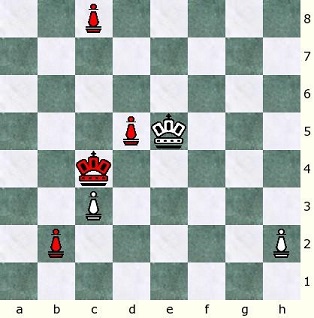
1.d1-d5 Dd7-d6 2.c1-c4 h8-h4 3.f1-f4 g8-g4 4.Dd2-d4 f8-f5 5.b1-b6 e8-e5 6.c4-c6 a8-a5 7.e1-c1 a5-c5xd5 8.c1-c4xc5 g4-g3 9.De4-e3 g3-f3xf4* 10.g1-g3xf3 e5-c5 11.De3-e5 b8-b7 12.g3-g5xf5 c5-b5xb6 13.a1-a6 b7-b6xc6 14.c4-c6xb6 b5-b6xc6 15.h1-h3 Dd6-c6xa6 16.g5-h5xh4 d8-d5* 17.h3-c3 Dc6-c4 18.h5-h2 b6-b2 0-1
- Latrunculi XXI
Joe Joyce (USA) - Jose Carrillo (CAN)
CV Game Courier, August 2016
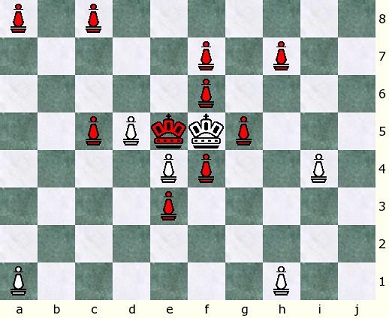
1.c1-c3 h8-h4 2.d1-d5 De7-e5 3.c3-c7 b8-b6 4.e1-e4* b6-c6xc7 5.Df2-f6 c6-c5xd5 6.g1-g5 g8-g6* 7.f1-f4 f8-f7* 8.j1-j6 e8-e6+ [9.De5-f5#] 9.j6-h6xg6 i8-g8 10.g5-g7 j8-h8 11.f4-g4 h8-h7xg7 12.Df6-f5(+) h4-h5xh6 13.b1-d1+ [14.d1-d5#] d8-d3 14.d1-d2 d3-e3xe4 15.d2-d5+ [16.g4-e4#] e6-f6* 16.g4-e4(+) g8-g5(+) 17.i1-i2?! h5-h4+! [mate in 1] 18.i2-i4 h4-f4# 0-1 - Latrunculi XXI
Vitya Makov (RUS) - Jose Carrillo (CAN)
CV Game Courier, December 2016
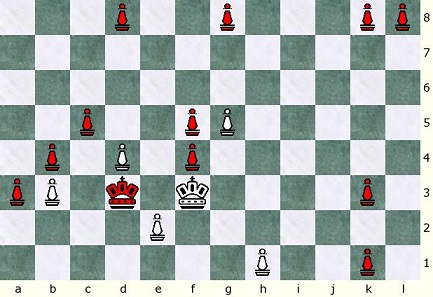
1.c1-c4 i8-i5 2.e1-e3 j8-j4 3.i1-i3 e8-e6 4.b1-b2 b8-b5 5.a1-c1 b5-b4 6.e3-e4 c8-c5 7.h1-h4 h8-h5 8.l1-l4 Df7-f3 9.Dg2-f2*?! Df3-h3xh4 10.j1-j3 Dh3-c3xc4 11.c1-c2* Dc3-d3 12.d1-d2* Dd3-e3 13.Df2-f3* e6-e5xe4 14.d2-e2* f8-f4* 15.f1-d1 h5-h2 16.g1-g2 h2-j2xj3 17.k1-k2 i5-i4 18.i3-i2xj2 j4-k4 19.i2-h2 i4-j4xl4 20.c2-c3 j4-j1 21.h2-h1 k4-k3 22.d1-d3(+) a8-a3 23.b2-b3 j1-k1xk2 24.g2-g5 e5-f5 25.d3-d4?? De3-d3xc3! [26... Dd3-c3xb3 or d8-d5xd4] 0-1 - Latrunculi XXI
Arx (USA) - Jose Carrillo (CAN)
CV Game Courier, December 2016

1.s1-s4 i8-i5 2.h1-h4 d8-d6 3.l1-l3 e8-e5 4.c1-c3 h8-h5 5.i1-i4 Df7-f3 6.d1-d3 Df3-h3xh4 7.i4-h4* Dh3-e3xe4 8.i3-f3* g8-g3xf3 9.h4-g4xg3 f8-f4 10.f1-f3* e5-g5 11.Dg2-e2(+) i5-i3! 12.g1-g3? i3-h3xg3 13.j1-f1? [better was 13.f3-g3!, redeployment (rule 12)] h3-g3xf3xg4 14.k1-k2 k8-k3 15.d3-d4 De3-d3 16.b1-b3 d6-d5xd4 17.De2-e3* a8-a3 18.k2-d2(+) g3-f3* 19.a1-a2 b8-b4 20.f1-e1 h5-h2 21.e1-e2?? f4-e4# 0-1
Game Courier Presets - Latrunculi XXI

Several sizes Latrunculi boards have been found in archaeological excavations. The game can be played on any one of the boards below.
Magnetic Chess Pieces: on 10x8, 12x8 or 8x8 boards
Draughts Pieces: on 10x8, 12x8 or 8x8 boards
Unchequered board with Go stones: on
10x8,
12x8 or
8x8 boards
Other Latrunculi sets:
By Carlos Cetina - Based on Chess Rooks, including a Royal Rook for the Dux: 12x8a and 12x8b:
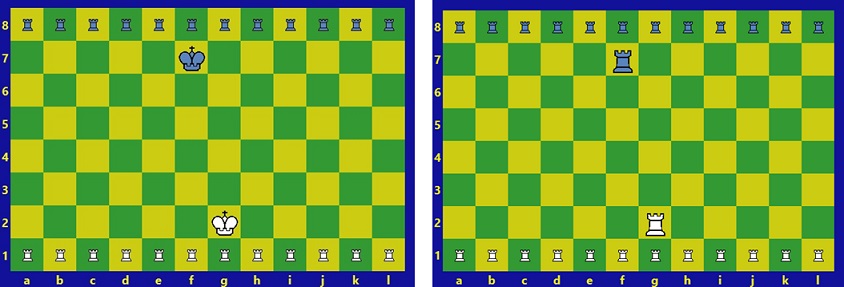
Single Stone Latrunculi XXI
This game is the same as Latrunculi XXI, but without any Duxes. It is mean to be a training tool to the basics of soldier movement in Latrunculi XXI. When you double the number of soldiers you get Petteia XXI.
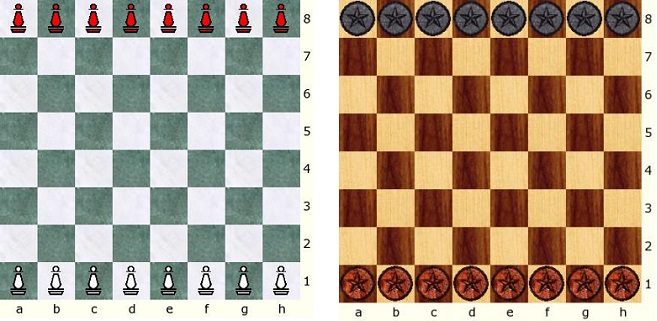
The game is played identically to Latrunculi XXI, but without Duxes. The objective of the game is annihilate the opponent's army and bring it down to either one or no soldiers left to battle, or to win by stalemating the opponent.
Game Courier Presets - Single Stone XXI
Magnetic Chess Pieces: on 10x8, 12x8 or 8x8 boards
Draughts Pieces: on 10x8, 12x8 or 8x8 boards
Â
Petteia XXI
With the instructions of Latrunculi XXI, you actually get two games in one! If you ignore any provisions made in Latrunculi XXI for the Dux, and use the setup below, exclusively using soldiers, you get Petteia XXI.

The game is played identically to Latrunculi XXI, but without Duxes. The objective of the game is annihilate the opponent's army and bring it down to either one or no soldiers left to battle, or to win by stalemating the opponent. Beware of the Phallanxes in this game. They are common and deadly!
Â
Game Courier Logs
Game Courier Logs for Games of Latrunculi XXI
Game Courier Logs for Games of Single Stone Latrunculi XXI
To see actual games that have been played on-line, follow the link above.
Â
Latrunculi XXI and Petteia XXI were created by Jose Manuel Carrillo-Muniz, from Puerto Rico in 2015.
Â
Chess Variants by the Author:
- Modern Chess Complex
- Modern Random Chess (9x9)
- Contemporary Random Chess (8x8)
- Prime Ministers Chess (9x8)
- Pseudo-Modern Random Chess (9x9)
- Chess8400 (9x9)
- Prime Ministers Contemporary Random Chess (8x8)
- Prime Ministers Random Chess (9x8)
- Hia Chess (9x8)
- Modern Capablanca Random Chess (10x8)
- English Chess Complex
- Modern English Random Chess (10x10)
- International Contemporary Random Chess (10x10)
- International Fischer Random Chess (10x10)
- Courier Chess Complex
- Courier Chess Moderno (12x8)
- Mini Courier Chess Moderno (10x8)
- Silver Elephant Chess (10x8)
- Modern Ministers Courier Chess (11x8)
- Ajax Complex
- Ajax Chess (10x10)
- Ajax Orthodox Chess (8x8)
- Ajax Random Chess (8x8)
- Ajax Modern Random Chess (9x9)
- Ajax Ministers Chess (10x8)
- Ajax Falcon Chess (10x8)
- Ajax-Capablanca Chess (10x8)
- Ajax 3D Chess (8x8x3)
- Korean Random Chess (9x10)
- Latrunculi XXI (10x8)
- Petteia XXI (8x8)
- Partnership Chaturanga (8x8)
Other Presets by the Author:
- Chaturanga - Davidson Variation on an original Indian ashtapada board (or on an uncheckered plain board)
- Modern Chess Preset
- Fischer Random Chess Preset
- Makruk (Thai Chess) Preset
- Modern Shatranj Preset
- Ajax Xiangqi (9x10) proposed by Charles Gilman
- Ajax Bigamous Chess (9x8) by Carlos Cetina
- Ajax Euchess (10x10) by Carlos Cetina
- Frolov Chess - Ajax Variation (9x9)
- Hiashatar (Mongolian Decimal Chess) (10x10)
- Milenium 3D Chess (8x8x3) by William L. D'Agostino
Other Pages by the Author:
- How to Generate Random Positions
- The Bishop Adjustment Rule
- The Modern Principles
- Reverse Symmetry
- The Prime Minister
- The Courier Elephant
- The 10x8 Variants
- Checkers Variants
 This 'user submitted' page is a collaboration between the posting user and the Chess Variant Pages. Registered contributors to the Chess Variant Pages have the ability to post their own works, subject to review and editing by the Chess Variant Pages Editorial Staff.
This 'user submitted' page is a collaboration between the posting user and the Chess Variant Pages. Registered contributors to the Chess Variant Pages have the ability to post their own works, subject to review and editing by the Chess Variant Pages Editorial Staff.
By Jose Carrillo.
Last revised by Jose Carrillo.
Web page created: 2016-06-12. Web page last updated: 2016-12-05
